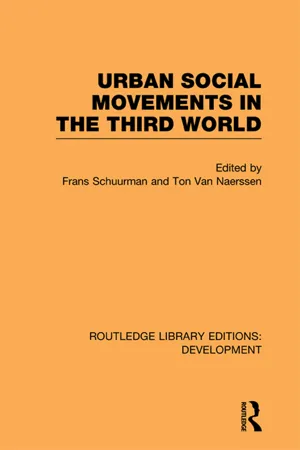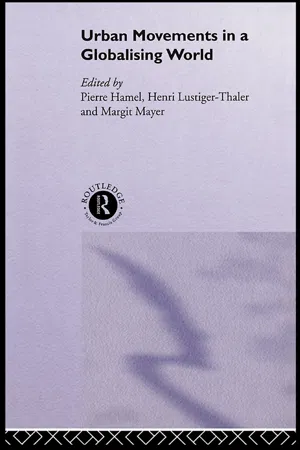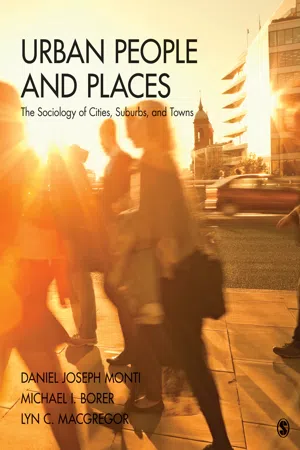History
Urban Reform Movement
The Urban Reform Movement refers to a period of social and political activism aimed at addressing the challenges of urbanization in the late 19th and early 20th centuries. It sought to improve living and working conditions in cities, advocating for reforms such as better sanitation, housing regulations, and labor laws. The movement was a response to the rapid growth of cities and the resulting social problems.
Written by Perlego with AI-assistance
Related key terms
3 Key excerpts on "Urban Reform Movement"
- eBook - ePub
- Frans Schuurman, Ton Van Naerssen(Authors)
- 2012(Publication Date)
- Routledge(Publisher)
In general it has apparently taken radical social scientists some time to get used to the above mentioned situation and to look for groups other than the labor proletariat which, at least potentially, could be carrying the red lantern of social change. This quest has resulted in (re)discovering the new social movements, whereby the urban social movements in developed and underdeveloped countries alike are considered to be of prime interest.DEFINITIONS OF SOCIAL MO VEMENTS
The international discussion on how to define urban social movements is increasingly characterized by a strong tendency towards academic involution, invoking reminiscences of the debate in the early 1970s on the nature of the informal sector. Sighs of relief then could be detected when Bromley and Gerry (1979) finally and rather pragmatically suggested not wasting any more energy on definitions of the informal sector and henceforth to focus on the “casual urban poor”, whether informal or not.Every author writing about urban social movements presents his own definition of the phenomenon. Reviewing a series of definitions it soon becomes clear that a criterion like “attaining societal transformation” is useful to bring about some order. If we use that criterion to construct a continuum, then we have on the one extreme those definitions which do not refer to external effects like societal transformation. These are dictionary type definitions of an urban social movement, e.g. “every collective effort in an urban context to solve a problem”.Moving along the continuum the definitions reflect an increasing leftist/radical political philosophy, whereby at the same time the potential number of urban social movements answering to the description is decreasing. This results in defining an urban social movement as a “collective action leading to societal transformation”. Some examples of definitions of an urban social movement strung along the continuum are the following:A specific form of collective action with a specific rationality, specific resources anda collective identity. (Roth, 1987) - eBook - ePub
- Pierre Hamel, Henri Lustiger-Thaler, Margit Mayer(Authors)
- 2003(Publication Date)
- Routledge(Publisher)
Besides their limitations, urban movements contribute to democratising processes around issues of local politics. This is the case if we look at their participation in local economic development. It is also true if we consider the way in which they are involved in the redefinition of social justice: they insist, among other things, on the necessity of revising an abstract vision of equity and replacing it with a more pluralist notion. In such a vision, the common good is no longer defined from above by a political elite, but it is defined through active negotiations between all concerned actors. Finally, the contribution of urban movements can be seen at an institutional level, in the active role they play in the redefinition of the public framework of action. Over the last few years it has probably been at this level—where the compromises between actors are best integrated—that these movements have been able to increase their influence.Urban movements are not homogeneous social actors with one type of social action. They do not necessarily share the same vision, nor are they committed to the same radical claims. However, they nonetheless tend to agree on the necessity of opening the debate and being directly involved in the redefinition of the public framework that underlies state intervention in urban development.Caught between a certain pragmatism reinforced by their institutionalisation, and a radicalism fuelled by their fragmentation and the deterioration of living conditions for an increasing part of the population, urban movements often engage in the defence of a ‘new cultural politics of identity, difference, and otherness’ (Soja 1994:4). It is from this standpoint that collective action introduces a revision of the old conception of social solidarity. Solidarity is no longer incompatible with the recognition and defence of identity (Donati 1995). It is in relation to values such as subjectivity and authenticity that grassroots and urban community groups engage in institutional innovation and push forward new socio-economic and political processes of democratisation. It is precisely these subjective aspects of collective action that the analytical lens of liberal universalism tends to neglect.In order more fully to develop these ideas, this chapter is divided into three sections. First, I discuss the way local politics have been transformed by conflicting interests and by the rise of new urban problems in the context of the post-Fordist era. Special attention will be given to local political institutions and to their capacity to resolve problems resulting from adjustments made necessary by the imperatives of the new world economic order. Next, I focus on collective action by community groups and urban movements, specifically considering their capacity to cope with the new urban issues of local economic development. Finally, I go back to local political institutions in order to understand the way in which social movements conceptualise a vision of social justice which challenges the traditional forms of local politics. Even though these aspects will be primarily analysed in theoretical terms, I will use examples from fieldwork done in Montreal in order to illustrate my arguments. - eBook - ePub
Urban People and Places
The Sociology of Cities, Suburbs, and Towns
- Daniel J. (Joseph) Monti, Michael Ian Borer, Lyn C. Macgregor(Authors)
- 2014(Publication Date)
- SAGE Publications, Inc(Publisher)
Social reforms were supposed to fix people more directly by creating new programs and organizations to provide much needed structure to the allegedly chaotic and “socially disorganized” lives of the people they were supposed to help. Early social reformers believed that most social problems were caused by the moral bankruptcy and improper training of these people. Typically, they looked at problems faced by families as the source of so much troubled or “deviant” behavior, especially the problems of children and younger unattached men and women. That’s why reformers often focused on how to improve a community’s organizational capacity. Only by providing institutions that drew problematic people into more conventional organizations such as schools could the mass of people in cities be shown how to overcome their own personal failings.The idea that there was an urgent need to make urban places and people better emerged in the first third of the 19th century in response to widespread city building and immigration. By the latter half of the 19th century, one would have included industrialization as another compelling factor driving people to undertake efforts to fix urban places and people. Both urban planning and social reforms eventually qualified asconcerns, that is, as matters calling for governmental engagement and intervention. But it took the better part of the 19th century for city leaders working on these problems to reach the point where government agents and offices assumed much of the responsibility for taming and improving the city.public policyThere was good news and bad news in this for traditional city leaders. On the one hand, upper-class people managed to engage parts of the public—their target audience—in their own reclamation. They accomplished this by having local governments take on many of the social programs these traditional leaders had pioneered. On the other hand, upper-class people turned the keys to city hall and city council chambers over to some of the very people they feared and despised most: immigrant voters and the corrupt politicians that represented them. The Progressive movement of the late-19th and early-20th centuries was an explicit reaction to the graft and enterprising criminality that local and state politicians brought to urban governance and policy making. But it also challenged all the business people from among their own ranks who cut deals with politicians in order to secure lucrative contracts to provide new and expanded public services to growing urban populations (Steffens, 1904/1969).
Index pages curate the most relevant extracts from our library of academic textbooks. They’ve been created using an in-house natural language model (NLM), each adding context and meaning to key research topics.


